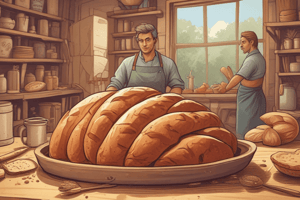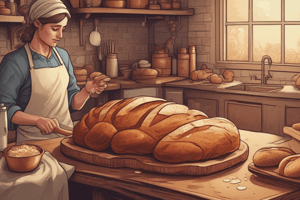Podcast
Questions and Answers
What is the primary challenge in creating a sour culture for bread making?
What is the primary challenge in creating a sour culture for bread making?
- Maintaining a consistent temperature
- Obtaining the right type of yeast
- Finding the right type of flour
- Isolating the desired microbes from their environment (correct)
Why may the yeast present on the outside of grapes not thrive in a medium of flour and water?
Why may the yeast present on the outside of grapes not thrive in a medium of flour and water?
- Because they are not able to break down complex sugars
- Because they are not adapted to the nutrients in flour (correct)
- Because they are sensitive to the pH of flour
- Because they are outcompeted by other microbes
What is the advantage of starting a sour culture with a flour mix high in bran and naturally present fermentable sugars?
What is the advantage of starting a sour culture with a flour mix high in bran and naturally present fermentable sugars?
- It reduces the risk of contamination
- It shortens the time required to obtain a sour starter
- It increases the likelihood of selecting for desirable microbes (correct)
- It eliminates the need for yeast
What is the term used in France to describe a fairly firm sour starter?
What is the term used in France to describe a fairly firm sour starter?
Why is it necessary to feed a sour culture a daily diet of bread flour and water?
Why is it necessary to feed a sour culture a daily diet of bread flour and water?
What is the initial mixture used to start a sour culture, according to the method outlined in Table 5.2?
What is the initial mixture used to start a sour culture, according to the method outlined in Table 5.2?
What is the primary reason for the initial burst of microbial activity in grapes crushed in water?
What is the primary reason for the initial burst of microbial activity in grapes crushed in water?
What is the likely outcome of starting a sour culture with a flour mix that is high in bran and naturally present fermentable sugars?
What is the likely outcome of starting a sour culture with a flour mix that is high in bran and naturally present fermentable sugars?
What is the primary benefit of using whole wheat flour in creating a sourdough starter?
What is the primary benefit of using whole wheat flour in creating a sourdough starter?
What is the ideal temperature for creating a sourdough starter?
What is the ideal temperature for creating a sourdough starter?
What is the effect of feeding the culture 3 or 4 times a day?
What is the effect of feeding the culture 3 or 4 times a day?
What is the consequence of maintaining a culture at a lower temperature?
What is the consequence of maintaining a culture at a lower temperature?
Why is it recommended to feed the culture at least twice a week at room temperature when refrigerating it?
Why is it recommended to feed the culture at least twice a week at room temperature when refrigerating it?
What is the result of using a lower hydration level in the initial mixture?
What is the result of using a lower hydration level in the initial mixture?
What is the characteristic of the aromas produced by the culture after 10 consecutive days of proper maintenance and feeding?
What is the characteristic of the aromas produced by the culture after 10 consecutive days of proper maintenance and feeding?
What is the purpose of changing the temperature and hydration level after the first day?
What is the purpose of changing the temperature and hydration level after the first day?
What is the benefit of stirring the culture at feeding time?
What is the benefit of stirring the culture at feeding time?
What is the risk of maintaining a culture at a temperature below 50°F?
What is the risk of maintaining a culture at a temperature below 50°F?
Flashcards are hidden until you start studying
Study Notes
Creating a Sour Culture for Bread Making
- Fermentation occurs naturally everywhere, and the challenge is to find and isolate the desired microbes.
- Sources like buttermilk, potato water, organic grapes, and outdoor air can be used to create a sour culture, but they may not provide long-term results.
- A sour culture started with grapes will show vigorous fermentation at first, but the yeast may not thrive in a flour and water medium.
- A flour mix high in bran and naturally present fermentable sugars is likely to give good results.
- Using whole wheat flour and medium rye flour is a good starting point, as they are easily available and provide the necessary nutrients for the culture.
Method for Creating a Sour Starter
- Mix whole wheat flour and medium rye flour in a 1:1 ratio with warm water (90°F) to achieve a 90% hydration.
- Hold the mixture at an ambient temperature of 85°F for 24 hours.
- After 24 hours, feed the culture twice a day with white bread flour and less water (60% hydration) and hold it at a lower temperature of 70°F.
Maintaining the Sour Culture
- Feed the culture regularly to promote yeast activity and eliminate unwanted microbes.
- Once-a-day feedings can work, but multiple feedings promote more yeast activity and complexity.
- Maintaining the culture at a lower temperature slows yeast activity and increases acidity.
- Refrigeration can be used to slow down the culture, but it's essential to feed it regularly to maintain viability.
Studying That Suits You
Use AI to generate personalized quizzes and flashcards to suit your learning preferences.





